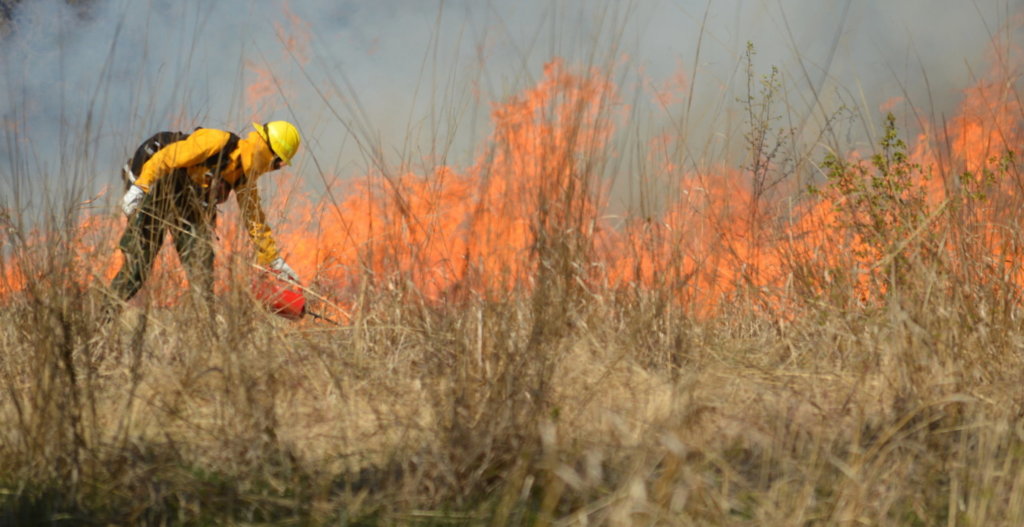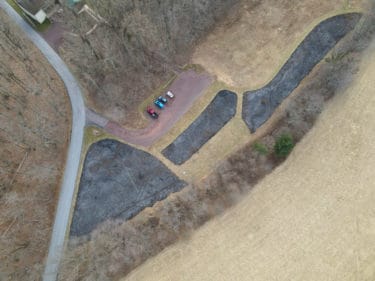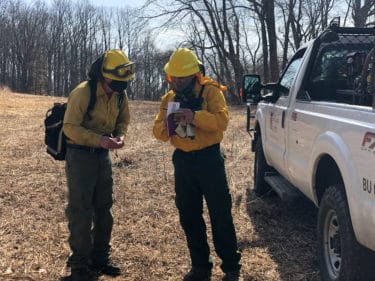what is a prescribed burn?
Prescribed burns are an ancient land stewardship technique that mimics the process of natural wildfires. Many species (including native grasslands, oak-hickory forests, and serpentine barrens) depend on periodic fires to maintain native plants and keep invasive vegetation at bay. These fires are referred to as “prescribed burns” because they act like medicine for areas whose health—including the animals and insects that live in them—is threatened by the aggressive growth of non-native plants. With training and experience prescribed burns are a technique that nurtures nature.
trial by fire.
On April 9, 2012, gusty winds toppled trees onto power lines running through French Creek State Park, which borders Natural Lands Crow’s Nest Preserve. The resulting forest fire lasted a week and became one of the longest-burning and most-expensive forest fires in Pennsylvania history. “There hasn’t been one this big or this hot in our area in 50 years,” said Darin Groff, Incident Commander for the fire, a certified PA Forest Fire Warden, and Natural Lands Fire Management Coordinator.
Yet, nearly four years to the day, the same area caught fire once more.
A few weeks later, two simultaneous fires raged through the Pocono Mountains, prompting local officials to request fire fighters from out-of-state to help battle the blazes, which ultimately burned more than 8,000 acres and 11 structures.
In 2020, there were 1,508 wildfires across Pennsylvania. The numbers nationwide are even more dramatic. Climate change has led to fire seasons that are now on average 78 days longer and that result in twice as many acres burned than three decades ago.
While climate change has played a role in the increase in wildlfires, most researchers believe changes in fire policy—namely, suppression at all costs—have had a profound impact on the frequency and severity of these fires.

natural fire.
For thousands of years, our forests experienced frequent naturally occurring fires, which promoted tree species and ecosystems that were both fire and drought resistant. But in the early part of the 20th century, public concern over wildfires led to a blanket policy of fire suppression. Firefighting crews were established across the country, including “smokejumpers” who parachuted from airplanes to extinguish flames in remote areas. In 1944, the Forest Service introduced Smokey Bear who instructed the public about the dangers of forest fires.
“We went from a moderate to large amount of fire to an era of overprotection,” said Marc Abrams, professor of forest ecology and physiology at Penn State. “With Smokey Bear, we have lost fire, and we need to get it back. This issue is on the radar screen of foresters.”
Abrams collaborated with the Eastern Regional Office of the U.S. Forest Service on a study published in 2016 in the journal Tree Physiology. The researchers categorized tree species according to drought tolerance and adaptation to fire, and examined the relationship between forest composition trends and land-use patterns, disturbance events, and historical weather records.
“The results of our research indicate that vegetation changes in the eastern United States are caused to a greater extent by clearing for agriculture, wood harvesting, introduction of non-native pests and diseases, and fire suppression than by climate change,” Abrams said.
As early as 1924, environmentalist Aldo Leopold argued that wildfires were beneficial to ecosystems, and were necessary for the natural propagation of numerous tree and plant species. Over the next 40 years, increasing numbers of foresters and ecologists concurred.
Finally, the National Park Service changed its policy in 1968 to recognize fire as an ecological process. Today, fires are allowed to run their courses as long as they could be contained within fire management units and accomplished approved management objectives. The challenge, of course, is to balance forest health with the danger wildfires pose to human life and property.
prescription for fire.
 Though it may sound like a contradiction in terms, controlled fire is one way to help achieve this balance. The U.S. Forest Service now routinely conducts “prescribed burns” to help reduce the risk of uncontrolled wildfires, to improve ecological conditions for native plants and wildlife, and to help control the spread of non-native plants and destructive pests or diseases.
Though it may sound like a contradiction in terms, controlled fire is one way to help achieve this balance. The U.S. Forest Service now routinely conducts “prescribed burns” to help reduce the risk of uncontrolled wildfires, to improve ecological conditions for native plants and wildlife, and to help control the spread of non-native plants and destructive pests or diseases.
Though on a far smaller scale, Natural Lands also employs prescribed burns on our preserves—and sometimes for other organizations. For more than two decades, fire has been part of a comprehensive approach to land stewardship.
“By conducting controlled burns, we use fire as a tool,” said Darin Groff, Natural Lands fire management coordinator. “We set the terms of the fire. The conditions have to be just right—the wind and humidity, the time of year, the recent weather. If things aren’t perfect, we cancel the burn.”
Staff members receive rigorous and ongoing training in wildland fire behavior, firefighting techniques, and fire safety protocols, including weeks of initial training with the National Wildfire Coordinating Group. At the state level, Natural Lands program integrates with the PA Department of Environmental Protection, the Bureau of Forestry, and the Pennsylvania Prescribed Fire Council Steering Committee. The crew—consisting of members of our Preserve Stewardship Department—is recognized as one of the most experienced and skilled wildland fire teams in the region.
“The results speak for themselves,” said Darin Groff, “We walk away from a burn with the plants charred black. But in just a few weeks you can see life—meadow grasses sending up new shoots, seedlings sprouting. Controlled burns aren’t a short-term fix; we are in this for the long game, and we’ve seen some pretty amazing results over the last couple of decades.”
how prescribed burns work.
 Prescribed burns can only be conducted in the spring under specific weather conditions: it can’t be too dry, too wet, or too windy. If any of these factors isn’t just right, the burn is called off. Natural Lands has been using this process for more than two decades to care for nature and the results are seen in the summer blooms, butterflies, and ground nesting birds who make their homes in the meadows of our preserves.
Prescribed burns can only be conducted in the spring under specific weather conditions: it can’t be too dry, too wet, or too windy. If any of these factors isn’t just right, the burn is called off. Natural Lands has been using this process for more than two decades to care for nature and the results are seen in the summer blooms, butterflies, and ground nesting birds who make their homes in the meadows of our preserves.
If the conditions are just right, the crew meets to review the plan for the burn. At these pre-burn meetings, the team develops a “prescription” plan for the burn and reviews individual assignments, weather conditions, fuels, and other elements of the burn.
The crew begins by lighting a test fire, to ensure that the fire conditions are within the required parameters for safety. If the test fire does not perform within these parameters, the burn is postponed.
Crew members may use strip-firing techniques, where fire is lit in strips five to 20 feet apart, allowing fire intensity and rate of spread to be carefully controlled. Wind and weather conditions are constantly monitored to ensure that burn conditions remain safe and that the objectives are being met.
After the burn, crew members carefully mop up the area to ensure that the fire does not re-ignite after they depart. The exposed soil—blackened and ash-enriched by the fire—will help native grasses and wildflowers germinate more quickly (soil temperatures will rise by about 10 degrees) and grow more vigorously.
fire fighters.
Our staff use their training and experience to help our community battle wildfires, both here in the region and across the country. Darin regularly participates in wildfire efforts across the country; lessons learned from these experiences are an invaluable part of his ongoing training. In 2015, Darin spent 16 days in Alaska as part of an incident management team battling the Fish Creek Fire, which burned more than 16,000 acres. Darin and other staff members also battled the Heights Fire and, later, the Pipeline One Fire, both in Carbon County, PA.
Some members of the Natural Lands fire team spent several days as part of a coordinated effort to fight the Hopewell Fires in both 2012 and 2016. “We don’t fight these kinds of fires with water,” said Darin. “There’s no way to get enough of it into the backcountry. So instead a lot of the work is to create firelines at a distance from the active fire—removing dead trees, brush, and leaf litter and exposing the soil—so that when the fire reaches them it goes out for lack of fuel. We create firelines with rakes and shovels and, if we can get equipment there, with small bulldozers. We will also use fire to burn out the fuels along the fireline that then burns into the main fire.” Staffers also serve as sawyers—felling smoldering trees—and swampers—dragging branches, rolling logs off the fire line, and cutting debris with chainsaws. It’s grueling work made more challenging by the required protective gear.
After the fire subsides, there’s still work to be done, so staff help with mop-up operations: extinguishing still-burning material.
“We do prescribed fires on our preserves that are shorter and simpler events, and we’ve all taken classes on how wildfire operations are managed, but there’s no substitute for participating in one,” said Dan Barringer, Crow’s Nest Preserve manager, who helped fight both Hopewell Fires. “The closest this fire came to Crow’s Nest Preserve is about 700 yards or four-tenths of a mile. As a neighbor to this fire myself I am grateful to all of the folks who put in their time and hard work to contain it.”
Prescribed burns take training, experience, and expertise to do properly. Our staff relies on decades of experience, the latest research, and ongoing training to use this technique. Our community supports the work we do by becoming a member and investing in our expertise in caring for nature here at home and across the country. Join today to care for nature.
